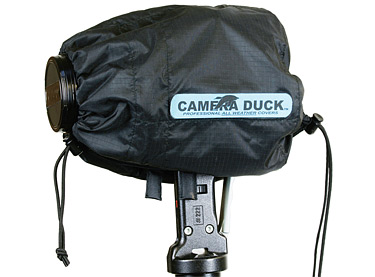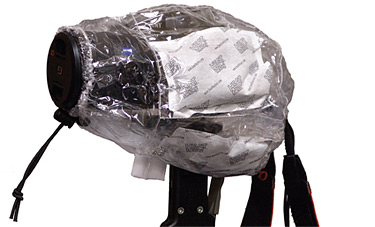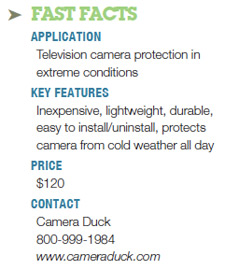Camera Duck Camera Cover

The Camera Duck protects cameras from the elements and keeps them from freezing too.
The wintry months often pose a double threat to the performance of pro video cameras. Cold and moisture can undermine the performance of sensitive and sophisticated electronics and the batteries which power them. Preventive measures are best taken to preclude performance problems. One option is to protect the camera with some sort of coat or cover. Several companies now offer a range of such products particularly for larger broadcast cameras and support gear, but few support smaller cameras nearly as well. However, one new company—Science Research & Development—has created a full line of "camera coats" and "camera covers," marketing these under the trade name "Camera Duck." The company makes covers for all sizes of cameras, including 2/3-inch sensor broadcast models on one end of the scale and smaller cameras, including DSLRs, on the other.
FEATURES
The Camera Duck is a flexible, weatherproof cover designed to enshroud and protect various cameras. It's open on both ends to accommodate the lens, with room at the back end for hands-on operation of camera functions, including all lens operations and the many functions activated via the side control panel. The Camera Duck covers are made with waterproof, rip-stop nylon to protect your camera from rain, snow, mist and spray, as well as from the effects of a blazing sun, blowing sand, salt particles and other such environmental factors that could adversely impact performance.
Each cover has built-in pockets on the inside capable of holding a maximum of four compact air-activated heating packs, similar to those cold-weather hand and foot warmers you find in the camping stores. These packs are odorless, non-toxic, and disposable, and can provide heat for up to 24 hours, even at sub-freezing temperatures. While the heat is mild, it's sufficient to keep the battery and key moving parts above 32 F.
Those of us who shoot video for a living know that when temperatures go below freezing, cameras may begin malfunctioning and batteries can lose storage capacity. The low, yet constant warmth provided by the heat packs within the Camera Duck help to keep both camera and battery some 20 to 30 degrees above ambient temperatures to ensure optimum performance. A drawstring cinch on both ends of the cover makes it possible to warm the camera evenly all around, especially when it's not in use. Obviously, camera rigs are going to cool down when exposed to the elements while being used. However, by keeping the camera and associated batteries above ambient temperature when not in use, the effects of cold weather can be warded off to a large degree.

This clear plastic model shows the placement of the heating packs that keep the camera warm. Camera Duck covers also help to retard lens fogging and condensation issues, which can be as problematic as diminished mechanical and electrical performance. Condensation occurs when bringing a cold camera indoors into a much warmer environment. And in addition to affecting optical performance, it can also adversely affect the camera's electrical circuitry.
As long as temperatures remain above 32 F the heat packs aren't required. Moreover, the nylon Camera Duck cover provides an effective buffer against heat loss encountered with wind chill at temperatures above 32 degrees. At even higher temperatures, Camera Duck becomes more of a raincoat/splashguard and provides lightweight waterproofing.
Depending on the prevailing environmental hazards, two different Camera Duck covers may be worn at once for added protection whether from blowing snow, rain, mist or dust. For example, the Downpour Cordura Camera Duck may be layered over the standard cover for added protection from heavy rain or snow and from colder temps—even when they go below zero. For extreme cold, the Polar model has three layers: the standard nylon Camera Duck for an inner shell, a Thinsulate insulated cover and a Cordura outer shell. This Polar model is designed to keep cameras operational in temperatures as low as –30 F.
IN USE
For evaluation purposes, I was provided with a "standard" Camera Duck—a black ripstop nylon shell geared for smaller cameras. Having previously used several different brands of camera coats (mostly custom designed for particular cameras), I found Camera Duck refreshingly easy to install on my Canon XH A1 camera. You simply slide the camera lens through one open end and cinch the drawstring tight on the back. I did this, pulling the drawstring on the open back end fairly tight, while leaving just enough slack to slip one hand beneath the cover for dialing in camera operating mode or other parameters. I also fastened the front end of the camera strap to a special canvas lens cover (and then to the handle) in order to be able to use a camera strap for carrying it beneath a jacket or under my arm to add extra protection from the elements when I wasn't shooting This left the bottom open for mounting to a tripod or camera brace, or for slipping my hands inside to operate the camera.
Once installed, the Camera Duck was so unobtrusive that I left it on for general use. I was then ready to take on rain, snow, dust or spray without inhibiting any functionality. Moreover, the device's loose fit enabled me to access all camera functions more or less normally, including camera menus and even flipping out the monitor.
In terms of weather protection, I used the Camera Duck in rain and snow with consistently good results. As long as the conditions were not too blustery, very little moisture got through. There was some leakage via the front and back openings, though, as it was necessary to leave a bit of slack to allow focusing operations and use of the optical viewfinder. Using a double cover is one way of reducing this leakage, but I only had one Camera Duck. However, in testing it during blizzard conditions I did install another brand of custom-made "camera coat" beneath it. While this made it a bit tougher to perform certain functions, it was still doable. More importantly, it also kept the camera very dry, even in blowing snow and rain. For both of these conditions, however, I had to add my own custom lens hood extension to keep rain and snow from accumulating inside the lens hood and on the lens.
With the additional camera coat, I needed to use the heat packs with Camera Duck on just a few occasions—those involving shooting outside for the better part of an hour or more at sub-freezing temperatures, and at times when condensation was a concern. Even without the extra camera coat installed, I was able to get by with using only one or two ordinary hand warmers in the Velcro pockets.
One trick was to improvise my own "second coat" and drape it over the Camera Duck. I used towels, windbreakers, light canvas bags and water-repellant fabrics. This kept rain or snow from falling directly onto the camera, especially when I was fumbling with the controls beneath the Camera Duck cover. Such double coverage enabled me to shoot for an hour or so in steady snowfall without camera or battery malfunctions. However, there's no denying that using just two heat packs—one on each side—made this process easier and smoother while keeping condensation to a minimum. I should note that I used "standard" six-hour hand warmers, instead of Camera Duck's special 24-hour heat packs.
SUMMARY
The Camera Duck cover did exactly what it purports to do, up to a point. I found that for use in intense rain or snow at least a double layer of protection is best, as a single layer can become damp after prolonged exposure to sustained heavy rain and/or wet snow. I also found that some amount of moisture can penetrate the barrier during normal operation due to the breaches on both ends and on the bottom. Adjusting the tension on the cinch cord can help alleviate this a bit, but a single layer won't prevent all leakage in the heaviest of downpours and snowfalls.
Given the modest pricing, though, it is well worth doubling up your Camera Duck whenever shooting in persistent rain or snow, as well as when working in dusty conditions. Actually, the Camera Duck is so lightweight and unobtrusive that a standard cover can be left on at all times for basic all-round weather protection. This is something that's well worth adding to your standard camera package if you often shoot in the great outdoors—especially wherever precipitation is possible.
Carl Mrozek operates Eagle Eye Media, and specializes in wildlife and outdoor subjects. His work regularly appears on the Discovery Channel, The Weather Channel, CBS, PBS and other networks. Contact him at eagleye11@gmail.com.

Get the TV Tech Newsletter
The professional video industry's #1 source for news, trends and product and tech information. Sign up below.
